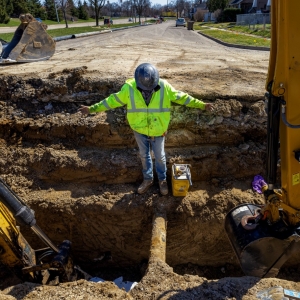Federal Water Tap, May 2: Senators Release Draft Text of Major Water Resources Legislation
The Rundown
- Senators release a draft $24.6 billion water resources and infrastructure bill for Army Corps projects.
- The EPA takes new actions to respond to PFAS chemicals.
- Senators introduce legislation to ban firefighting foams containing PFAS chemicals, settle water rights for the Hualapai Tribe, and provide grants for under-the-sink water filters.
- A New Mexico representative hints at future legislation regarding the Rio Grande and water data.
- The EPA Office of the Inspector General releases its plan for ensuring the agency does not waste federal infrastructure funds.
And lastly, the Department of Energy is seeking information on hydropower operations in a changing climate.
“As a water resources professional, I’ve worked in water resources science most of my career and am proud water nerd as I often say. I know through my decades of work on this issue, that we have to provide the best data and tools to our communities, and to collaborate and use community-based processes to tackle these challenges.” — Rep. Melanie Stansbury (D-NM) speaking at a House committee hearing on climate action. Stansbury said that in the coming weeks she would introduce two bills to address these issues. One bill will focus on resilience in the Rio Grande basin. The other will be a national water data act.
By the Numbers
$45 Million: Money that two mining companies — Kinross and Sunnyside — will pay to clean up abandoned mines in southwestern Colorado, a Superfund area that includes the Gold King mine, which spilled heavy metals into the Animas River watershed.
News Briefs
EPA PFAS Actions
Three more agency actions to respond to ‘forever’ chemicals in the country’s waters.
One is a new method for detecting PFAS compounds in water samples.
A second action is a memo that outlines how the EPA will address PFAS in pollution permits for industrial and wastewater treatment plant discharges into waterways. It applies to agency-issued permits in states and tribal areas where there are no water quality standards for PFAS. The memo describes steps for monitoring
Third in the list are draft guidelines for PFOA and PFOS in rivers and lakes. The guidelines, which states and tribes can use when setting their water quality standards, are intended to minimize harm to aquatic species. The EPA guidelines are not an enforceable regulation.
Water Bills in Congress
A couple legislative items of note:
- The PFAS Firefighter Protection Act was introduced in the Senate. The bill would prohibit, within two years, making, importing, or selling firefighting foam containing PFAS chemicals. The foams are a major source of the chemicals in groundwater, rivers, and lakes. The bill also would ban airports from using such foams by 2024.
- The Hualapai Tribe Water Rights Settlement Act would affirm the tribe’s claims to several rivers that flow in Arizona: the Bill Williams, Colorado, and Verde. It allows for the creation of a $180 million trust fund to construct the facilities necessary to divert 3,414 acre-feet per year from the Colorado River. The tribe’s 1 million acre reservation abuts the Colorado River in northwestern Arizona.
- The Healthy H2O Act was also introduced in the Senate. The bill would establish a grant program to purchase water filters for homes, apartments, and childcare facilities. These filters would be installed below the sink or at the point where water enters the building. Eligible buildings are those where testing shows the presence of one or more contaminants. The legislation does not mention a contaminant threshold, such as exceeding a state or federal health standard.
In context: Treating Drinking Water at the Faucet Is Rarely a Utility’s Contamination Solution
Studies and Reports
Overseeing Infrastructure Bill Spending
The EPA Office of the Inspector General, the agency’s internal watchdog, released its plan for ensuring that Infrastructure Investment and Jobs Act funds are not misspent.
The act provided the OIG with $270 million over five years to audit the agency’s implementation. The majority of the infrastructure act funds allocated to the EPA are designated for improvements to water systems.
Priority areas for the inspector general are lead service line replacement, climate resilience for water systems, Superfund cleanups, and tribal administration of water systems.
On the Radar
Water Resources Development Act
Senators on the Environment and Public Works Committee released the draft text of a bill that will fund Army Corps water infrastructure projects.
Engineering-News Record reports that the Water Resources Development Act will authorize $24.6 billion in feasibility studies and construction projects for areas ranging from flood and erosion protection to ports and dams.
The committee will mark up the legislation on May 4.
Info Request: Hydropower and Climate Change
The Department of Energy is seeking advice on the research and data needed to inform hydropower operations and planning under climate change scenarios. The department undertook this work for federal hydropower assets. It is now extending the analysis.
The deadline for providing feedback is June 6. Submission guidelines and questions of interest are in the above link.
Federal Water Tap is a weekly digest spotting trends in U.S. government water policy. To get more water news, follow Circle of Blue on Twitter and sign up for our newsletter.
Brett writes about agriculture, energy, infrastructure, and the politics and economics of water in the United States. He also writes the Federal Water Tap, Circle of Blue’s weekly digest of U.S. government water news. He is the winner of two Society of Environmental Journalists reporting awards, one of the top honors in American environmental journalism: first place for explanatory reporting for a series on septic system pollution in the United States(2016) and third place for beat reporting in a small market (2014). He received the Sierra Club’s Distinguished Service Award in 2018. Brett lives in Seattle, where he hikes the mountains and bakes pies. Contact Brett Walton






Leave a Reply
Want to join the discussion?Feel free to contribute!